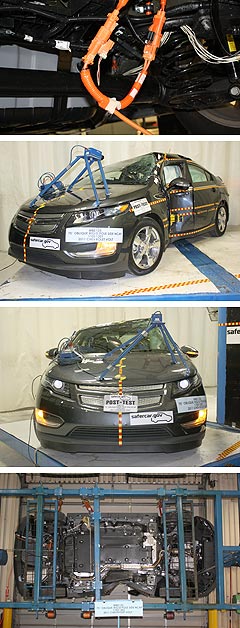News - Holden - VoltVolt fire probe raises GM hacklesEV smash: The Chevrolet Volt undergoes a US National Highway Traffic Safety Administration side-impact pole crash test. Crash testers did not discharge battery on Chev Volt that went up in smoke, says GM14 Nov 2011 UNITED States vehicle safety investigators have themselves come under scrutiny after a crash-tested Chevrolet Volt went up in smoke in a Wisconsin holding yard three weeks after a side-impact pole test that sealed a five-star rating for General Motors’ plug-in hybrid car. GM has effectively accused the crash testers of the official US National Highway Traffic Safety Administration of failing to take a few simple steps to “de-energise the battery” in a protocol required in the field by GM. Instead, the wrecked Volt was left with powered-up lithium-ion batteries and leaking coolant that apparently crystallised on cold nights, eventually shorting out the battery and causing the car to catch fire, along with others in the yard. NHTSA regulators have subsequently contacted all electrified vehicle car-makers, including GM, Nissan, Mitsubishi and Ford, with questions about the fire risk of lithium-ion batteries. The investigation following the fire in June was not publicly announced, but when details leaked last week, GM went public with a statement denying the Volt was an unsafe car. GM chief engineer for EVs Jim Frederico said: “First and foremost, I want to make this very clear: the Volt is a safe car. “We are working co-operatively with NHTSA as it completes its investigation.  Left: The Chevrolet Volt's high voltage leads. Below: Images of the Volt following the NHTSA side-impact pole test. Left: The Chevrolet Volt's high voltage leads. Below: Images of the Volt following the NHTSA side-impact pole test.“However, NHTSA has stated that, based on available data, there’s no greater risk of fire with a Volt than a traditional gasoline-powered car. “Safety protocols for electric vehicles are clearly an industry concern. At GM, we have safety protocols to de-power the battery of an electric vehicle after a significant crash. “We are working with other vehicle manufacturers, first responders, tow truck operators and salvage associations with the goal of implementing industry-wide protocols.” The Volt is due to go on sale in Australia under Holden badges from late next year. Holden senior product communications manager Kate Lonsdale told GoAuto that, because the launch of Volt was still some way off in Australia, the American investigation had no direct impact on Holden or its plans to launch the car here. “We are keeping in the loop, but none of that is affecting us,” she said. Mitsubishi and Tesla so far are the only original equipment manufacturers to offer lithium-ion battery EVs for sale in Australia, although Nissan is trialling its all-electric Leaf and Toyota has a fleet of plug-in hybrid Prius cars in a similar test locally. Mitsubishi Motors Australia head of corporate communications Lenore Fletcher told GoAuto today that the i-MiEV electric car automatically isolated its battery in any crash to minimise danger to occupants and emergency workers. She said Mitsubishi also had global safety protocols for handling i-MiEVs, and these were distributed to relevant organisations in Australia such as towing companies and emergency services. After the news of the Volt incident broke in the US, NHTSA released a statement saying it did not believe the Volt or other electric vehicles posed a risk greater than ordinary petrol-powered cars. “As manufacturers continue to develop vehicles of any kind – electric, gasoline or diesel – it is critical that they take the necessary steps to ensure the safety of drivers and first responders both during and after a crash,” it said. “Based on the available data, NHTSA does not believe the Volt or other electric vehicles are at a greater risk of fire than gasoline-powered vehicles. “In fact, all vehicles – both electric and gasoline-powered – have some risk of fire in the event of a serious crash.” According to a Bloomberg report, GM and NHTSA both crashed a Volt in an effort to replicate the fire, but could not do it. GM spokesman Greg Martin was quoted by Bloomberg as saying that GM had safety protocols for handling the Volt and its battery after an accident. “Had those been followed, there wouldn’t have been a fire,” he reportedly said. The 2012 Chevrolet Volt was awarded an overall five-star crash rating in the tests done by NHTSA in May this year, although the car was awarded four stars in the frontal crash test when the front-seat passenger test dummy was deemed to have suffered a higher head impact criteria on impact. Starting with 2011 models, NHTSA introduced the side pole impact test, done at 20 miles per hour (32km/h), striking a pole at a 75-degree angle just behind the A pillar on the driver’s side. After the test, the crashed car is given what is dubbed a rotisserie test, turned on its sides and roof to check for flammable fluid leaks, all of which were apparently satisfactory. In accordance with usual safety practice, the Volt’s petrol tank was drained, but the lithium-ion batteries left charged. The coolant did leak, but as it is regarded as non-flammable in its liquid form, the car was parked and forgotten.  Read more |
Click to shareHolden articlesResearch Holden Motor industry news |

















Facebook Twitter Instagram